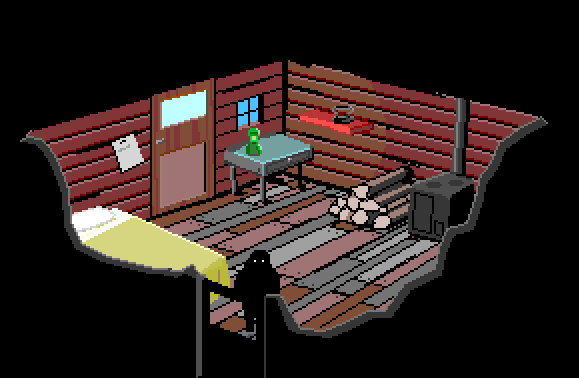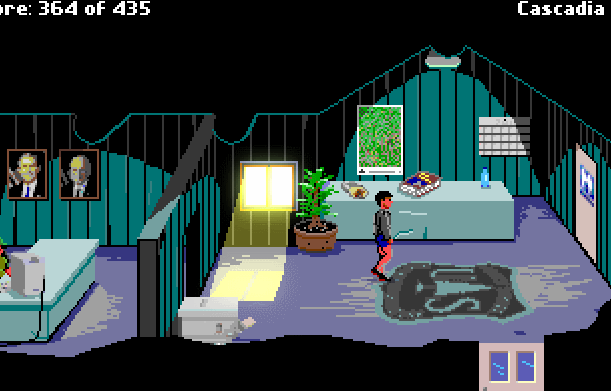Posted on February 23, 2019
More verb handling tidbits
As promised in the previous post, I said I would discuss some of the other features in my verb handling framework.
Strong nouns
Often there are multiple objects of the same type in a room. A common scenario is two doors. With nounless support, you can move the player over to a door and just type ‘open’, and it will work.
Similarly, you could type ‘open door’, and it will by default match against the one that is closest to the player (or closest in their field of view, rather). So generally this does what you expect.
Additionally, when you add more descriptive qualifiers to a noun, they are generally ignored. So when typing ‘open the front door’ or ‘open the stupid door’, the parser will still just match against ‘door’. That extra flexibility makes the parser more flexible and fun to use. We just try to glean the general intention.
However, sometimes you want to be more specific. There might be a green button and a red button. By default, the noun associated with each object will just be ‘button’, so that ‘push button’ will work with whichever button is in front of you. But typing ‘push green button’ when standing in front of the red button will end up matching against the red button. Not what we want.
So in addition to the noun that is associated with each in-game object, I have added the concept of a strongNoun that has additional qualifiers. These aren’t commonly used, but the verb handling logic will first look for any objects that have these and try matching against them first. Then if none are found, it uses the regular noun.

The noun for the front door is ‘door’, but the strongNoun is ‘front door.
Alternate nounless handlers for general locations
This is something I’m still experimenting with and still changing, but I’ll describe what I have so far.
It was motivated by the common scenario where there might be something on the ground that looks interesting, but you don’t know what it is. Or perhaps something on the ceiling above you. The typical nounless support in Cascadia Quest will work by sorting objects in the player’s field of view. But something on the ceiling will likely get lower priority than an object right in front of you. So just typing ‘look’ won’t describe the interesting thing on the ceiling above you.
Now, you could explicitly handle “look up” or “look ceiling”, and then check to see where the player is and try to describe any objects that you know are up there. But I’d rather have a more automated version of this.
So I now have a mechanism where an object can be tagged as being “on the ground”, “up”, or “on a wall”. So when the player types ‘look up’, for instance, it will be treated like a regular nounless ‘look’, except the matches will be limited to those objects that are tagged as being “up”. Likewise ‘look at the ground’ will be a ‘look’ limited to objects tagged as being on the ground.

The logo on the floor is tagged as being on the ground, and the lights on the ceiling are tagged as being up.
This is still a work in progress, and isn’t trivial. The game world isn’t really 3d, so that makes things a bit more complex since I don’t necessarily have a reliable sort order for objects above you or below you.
Along with this, I’ve made a distinction between vLook and vNounlessLook. By default they are treated the same (see the last post, about remapping verbs). But sometimes you might want to offer a different description if the noun wasn’t supplied. For instance:
‘look at ground’ -> You see what appear to be footprints.
‘look footprints’ -> The footprints look like they were made by a large animal.
A more flexible implementation might be to create a new object that represents ‘up’ (or some other open-ended spatial concept), and have the appropriate regular objects associated with it. Basically associating each regular object with a spatially aware thing that the parser can recognize.
As I continue building the game, I’ll see what scenarios arise and how I might address them.
Player zones
A scenario that has occurred fairly frequently in development is where there is an object on screen that the player can see and somewhat interact with, but that they are not physically able to approach (for instance, it might be out of reach up on a cliff).
This is such a frequent occurrence that I built some functionality into my framework to try to handle this automatically. Each object (including the player character) is assigned a player zone. An object can be present on more than one player zone (so it is a bitfield). By default every object is in player zone 1, so there is nothing special to do.
But in rooms where there are physically separate areas (e.g. up on top of a steep cliff vs. on the ground down below), each object is assigned a different zone. You can still interact with objects in a zone different than the player if the verb you use is a far verb for that object. But if the verb is a near verb, the game will automatically pop up a message saying something to the effect of “You can’t get to [insert object name] from where you are.” An object can customize the message if necessary. For the most part though, this requires little work on the part of the developer (me) – just correctly assigning player zones for each object.

In this case ‘look’ is a far verb, and ‘get’ is a near verb.
Unsolved challenges
Although the grammar parser in most cases supports identifying the order in which items are referenced (e.g. “give cat to dog” vs “give dog to cat”), I pretty much ignore this once I convert it to my verb/item/item format. This means that it is either up to the dog object or the cat object to handle vGive with a cat or a dog. If one doesn’t handle it, the fallback handling will eventually try the other object.
So of course what happens in the end, is that we’ll use verb metadata (such as whether this is a near or far verb) provided by the object that does handle it, and that could have some unintentional side effects. Nothing insurmountable, but it’s not a fully fleshed out area.
Another unsolved issue I have is with approach positions for moving characters. Most objects are fixed, and they tend to have a specific position on the screen that the player will move to when a near verb is used with that object (like “get grapes”). For NPCs that move around, however, the approach position may not be a fixed point. I currently don’t have any support for this, so I either don’t use any near verbs on NPCs, or I assign a fixed position that is roughly close to the locations they are patrolling or moving around. Ideally (I guess?) I would have the option of making the NPC stop and face the player, and then dynamically assign an approach position the NPC. This gets a bit tricky though, because I need to make sure that the approach position is in the pathfinding area that the player can walk to.

